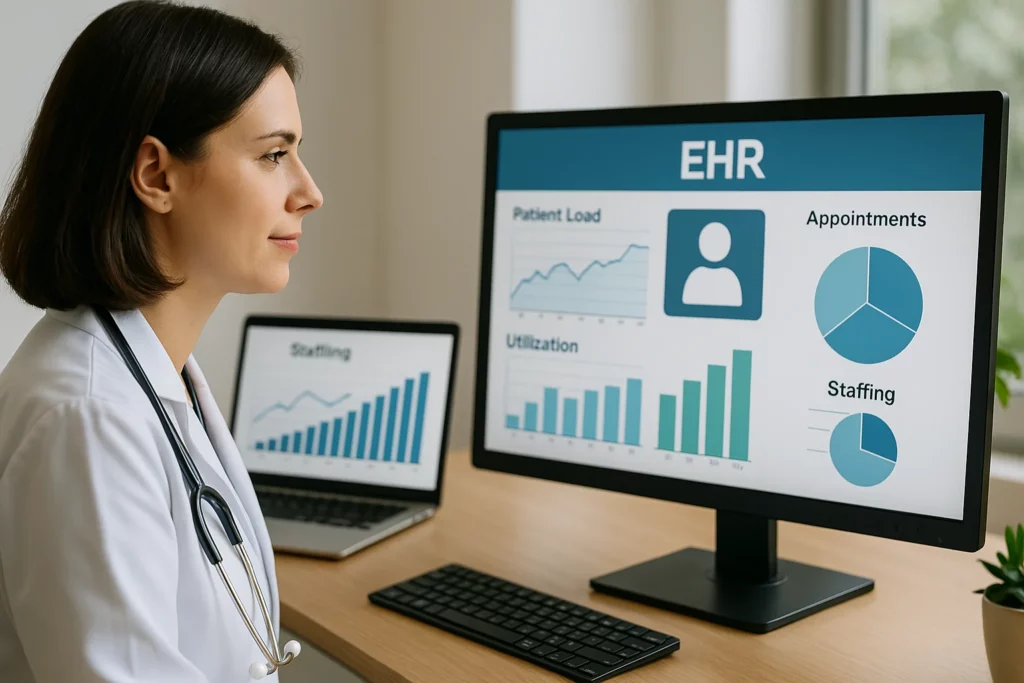When it comes to delivering great care, or as is known in the healthcare world, quality outcomes, few numbers matter more than the staff-to-patient ratio. For healthcare providers who deliver this care, especially smaller practices like hospices, clinics, etc., this number isn’t just a measure of workforce size but a key performance indicator that determines the quality of patient experience, the operational efficiency of the business, and even long-term viability.
Research has shown that in hospital settings, nurse-to-patient ratios can have an impact on patient mortality rates, with understaffing increasing the risk of patient deaths. While hospitals do indeed have layers of administration and funding structures to help manage these staffing levels, smaller independent healthcare practices also need to strike a balance between budget constraints and staffing numbers. This impacts patient care. Knowing how to best optimize staff-to-patient ratios isn’t an option; it’s essential.
Why Staff-to-Patient Ratio Matters
Specifically, the staff-to-patient ratio measures how many healthcare employees are available to care for each patient. While the most discussed example (as noted above) is the nurse-to-patient ratio, this concept applies broadly across many types of “care teams”. Studies published in journals like Health Affairs and BMJ Open (a UK publication) have linked higher nursing workloads with increased patient complications. Research continues to demonstrate that lower staff-to-patient ratios (i.e., more staff per patient) result in better outcomes. This includes fewer medical errors and higher patient satisfaction scores.
But here’s the nuance: optimal ratios depend on the healthcare setting. A hospice center with patients requiring round-the-clock palliative care will have different needs than a pediatric therapy practice, where appointments are short and scheduled in advance. That’s why defining what “safe staffing” looks like for your specific practice is so critical.

Defining and Calculating the Right Ratio
The Nursing Home Reform Act of 1987 mandated certain minimum staffing levels, such as eight hours per day of registered nursing service. We mention this as it was a direct and major piece of legislation that set standards for what is considered quality care in a specific healthcare setting (like in a nursing home). They become obligated to meet these specific standards if they are to receive any Medicaid or Medicare funding. It was enacted to protect seniors from various forms of abuse, be it physical, emotional, or types of neglect. Since then, the Centers for Medicare & Medicaid Services (CMS) has expanded such requirements and has issued rules for long-term care facilities.
Still, there’s no universal “magic number” that works for every sort of healthcare provider. For smaller and mid-sized healthcare entities, calculating an ideal staff-to-patient ratio means making an effort to look at your patient load, the acuity of cases, the duration of appointments, and the multitude of administrative responsibilities that are part of doing business. Importantly, the ratio must consider the support staff, whether it is medical assistants, patient transfer help, and even receptionists, meaning not just the licensed professionals involved.
Let’s take the case of a mid-sized physical therapy clinic. When they first approached Walters Accounting, their ratio averaged one therapist for every nine patients daily. On paper, it seemed manageable. But a closer look revealed high patient churn, and a degree of staff burnout. By digging into their patient data and cost structures, we helped them adjust schedules, stagger part-time staff, and integrate a better software platform that provided improved online documentation and appointment booking. The revised ratio became closer to 1:6. Not only did staff morale improve, but so did the revenue from the business since therapists could focus on care, meaning patient satisfaction, rather than paperwork.
In another instance, a mid-sized home healthcare agency in northern Florida was struggling with burnout. The team wore multiple hats; they had to handle billing, scheduling, and what seemed to be endless patient communications that often led to errors and delays. By reviewing their overhead, it was recommended that they reallocate some of their marketing budget (which was producing little return) toward hiring an experienced office coordinator. That one change shifted their daily workflow dramatically. Suddenly, the clinicians could focus on patient care while administrative tasks were taken over and handled more smoothly. Their overall staff-to-patient ratio was improved without the need for additional clinical hires.
Improving Staff-to-Patient Ratio: Practical Strategies
That said, not every solution involves hiring. Sure, bringing on more staff can help, especially in areas with high patient acuity or the complexity and severity of a patient’s medical condition. This not only focuses on resource allocation, such as staffing needs but also the care priorities for patients.
However, there are also other strategies to improve staff-to-patient ratios. These may include:
- Training: By “upskilling” current staff, a business can handle more tasks more efficiently.
- Technology: We often tout this as an important consideration, as tools such as scheduling platforms and EHR systems with automated reminders can save time and money.
- Outsourcing: Non-clinical functions like billing, audits, and compliance reviews can be delegated to outside firms (and yes, accounting businesses like Walters can help here).
- Team Redesign: Mixing full-time, part-time, and per-diem roles is another strategy to consider, as it offers ways to manage staffing, so it is flexible during peak workload hours.
Let’s say you run a behavioral health practice for mental health and substance use disorders. You may not need a full-time billing specialist, but outsourcing to a firm that understands healthcare can free up time and be a direct path for improving cash flow. Or, if your practice uses manual intake forms, switching to a digital format can save 5-10 minutes per patient. While that may not seem substantial, time like that does add up over the day.

The Role of Technology
Technology doesn’t just help with efficiency; it also improves visibility. With the right systems and platforms, healthcare managers can track staff utilization rates, patient flows, and appointment no-shows. For instance, integrated EHR (electronic health record) systems can alert providers when patient loads are trending too high so that employees can adjust.
Staffing software can even model a business’s future needs based on historical trends. This is especially helpful in practices that have seasonal fluctuations in their patient loads, as is the case with businesses like allergy and asthma clinics or sports rehabilitation centers.
Indeed, technology will continue to evolve and hopefully make patient care better while helping the staff handle their workload. For instance, with the ever-growing option of telehealth expanding, staffing considerations will be impacted. You may need fewer in-office receptionists but more IT support or remote schedulers. Needless to say, evolving technologies are reshaping how we think about staff-to-patient ratios.

Avoiding Common Pitfalls
Even with the best intentions, it’s not uncommon to miscalculate staffing needs. Some of the more common errors can include:
- Ignoring patient acuity: Not all patients require the same time or resources. This must be at the forefront of your thinking.
- Overreliance on averages: Looking at average patient counts without accounting for daily (and seasonal) peaks can leave healthcare businesses understaffed.
- Poor data tracking: Without solid data, you’re guessing at your staffing needs. The helpful lookback of data is often ignored as staff tend to focus on the daily needs of patients and accompanying administrative tasks at hand.
Take a hospice provider we recently worked with. Their reports showed consistent patient volume, yet staff complaints about overtime were growing. As it turns out, they had several high-acuity patients that demanded more hours per visit. By factoring in acuity and adjusting their staff assignments to certain patient “types” accordingly, we helped them reduce overtime by 25%.
Staffing Ratios and Patient Care: Looking Ahead
At the end of the day, all of this comes back to care quality. When your staff is spread too thin, mistakes happen. Patients notice rushed appointments, delayed callbacks, and a lack of personal touch. That affects everything from online reviews to return visits to reimbursement rates. And for smaller practices, it may be less about heavy regulation on what’s demanded for staffing levels (think large hospitals) but about long-term operational and financial sustainability.
Add to this a rapidly shifting healthcare environment where staffing will include even more automated elements such as artificial intelligence, smarter scheduling technology tools, and even real-time analytics. Telehealth and hybrid care models will also demand new staff roles that redefine traditional ones.
Outside assistance, such as accounting firms like Walters, are increasingly partnering with healthcare providers to track the key performance indicators (KPIs) so that they can build more flexible and responsive business models. Often, this means adjusting payroll structures, identifying cost-saving opportunities, reallocating staff based on needs, and even projecting tax burdens. By having another perspective, improving staff-to-patient ratios isn’t about helping a business hit a fixed number but about building a system that adapts to reflect patient and staff needs to advance the business’s mission for quality care and outcomes.







